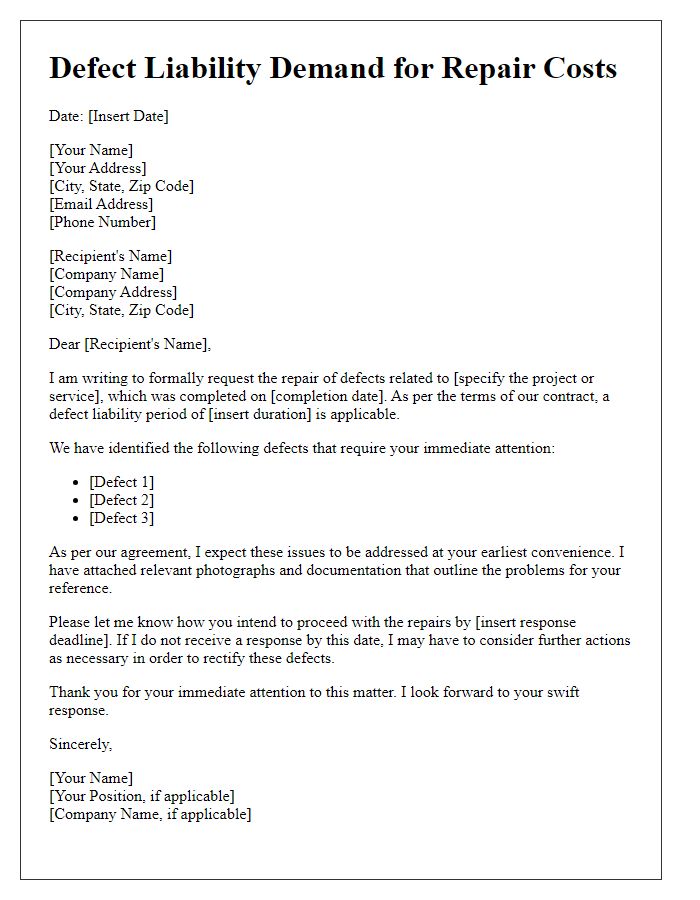Welcome to our guide on crafting a strong letter for a defect liability legal claim! If you've encountered issues with a recent property or construction project, you're not alone, and it's essential to know your rights. Writing a clear and effective letter can set the stage for a successful resolution, ensuring that your concerns are addressed. Dive into our article to discover tips, templates, and expert advice that will empower you to take action and protect your interests!

Clear identification of parties involved
In a defect liability legal claim, clear identification of parties is crucial. The Claimant (property owner), typically an individual or corporate entity, seeks compensation for defects from the Respondent (contractor or builder), responsible for construction or renovation work. The Claimant's details should include full legal name, address, and contact information, while the Respondent's identification must include the official company name, registered business address, and relevant licensing information. This clarity establishes the legal relationship between parties, ensuring accurate communication during the claim process. Proper documentation, including contracts, correspondence, and invoices, further supports the identification of each party's obligations and roles.
Detailed description of the defect and its implications
Defective construction materials, such as substandard concrete used in the foundation of a residential property in Springfield, can lead to significant structural issues over time. These materials may deteriorate prematurely, causing cracks in walls and uneven settling of the building, which compromises the safety and integrity of the structure. In severe cases, this can result in costly repairs, legal disputes, and potential relocation of tenants. Furthermore, defects related to plumbing systems, especially outdated piping materials, can lead to leaks or water damage, impacting the overall living conditions and resulting in mold growth. Such implications not only affect property value but also pose health risks to occupants, highlighting the urgency for remediation under prevailing defect liability laws.
Reference to contract and defect liability clause
In a construction context, the defect liability clause is crucial for ensuring quality and accountability. This clause typically stipulates the duration of time--often ranging from 6 to 24 months--after project completion during which the contractor remains responsible for fixing any defects in materials or workmanship. Specifically, within the context of contracts such as the NEC (New Engineering Contract) or FIDIC (Federation Internationale des Ingenieurs-Conseils) conditions, this clause establishes the rights of the owner and obligations of the contractor to repair identified defects. For a legal claim, it is essential to reference specific contract sections, providing a detailed account of the defect, its impact on functionality, the timeline for reporting, and any previous correspondence regarding the defect resolution. Failure to adhere to these stipulations could lead to legal consequences, including financial penalties or the need for further corrective actions beyond the liability period.
Timeline of events and responses
Timeline of events showcases crucial developments in the context of a defect liability legal claim. Initial incident occurred on January 15, 2023, when cracks appeared in the concrete foundation of a commercial property located in downtown Chicago, Illinois. A detailed inspection was conducted on January 20, 2023, revealing substandard workmanship. On January 25, 2023, the property owner submitted a formal complaint to the contractor, demanding corrective actions. The contractor responded on February 5, 2023, denying liability for the defects, citing improper maintenance from the owner's side. In response, the property owner hired a structural engineer on February 10, 2023, whose report confirmed the contractor's failure to adhere to building codes. Further correspondence was exchanged, but the contractor failed to propose a reasonable solution by the deadline of March 15, 2023. Legal counsel was retained on March 20, 2023, resulting in a formal legal claim submitted on April 1, 2023, asserting breach of contract and requesting reparations for damages incurred due to the defective work.
Requested actions and deadline for response
Defect liability claims can arise from construction projects, where contractual obligations require the contractor (such as Company XYZ) to rectify any defects discovered within a specified timeframe following project completion. Noting critical details about the project (Project ABC), including its location (1234 Elm Street, Springfield) and completion date (June 30, 2023), is essential. The deadline for the contractor's response is typically stipulated in the contract, often 30 days from the date of the claim notification. While waiting for the contractor's acknowledgment, it's crucial to document all identified defects (e.g., structural cracks or plumbing issues) and associated costs for rectification (estimated at $5,000 in repairs). Engaging a qualified inspector to verify issues could also strengthen the claim's validity.
Letter Template For Defect Liability Legal Claim Samples
Letter template of defect liability notification for construction project.

Letter template of defect liability correspondence for defective materials.












Comments